The NVIDIA GeForce RTX 2080 Ti & RTX 2080 Founders Edition Review: Foundations For A Ray Traced Future
by Nate Oh on September 19, 2018 5:15 PM EST- Posted in
- GPUs
- Raytrace
- GeForce
- NVIDIA
- DirectX Raytracing
- Turing
- GeForce RTX
Compute & Synthetics
Moving on to the low-level compute guts of the cards, we take a look at compute and synthetic results starting with tensor core accelerated GEMM.
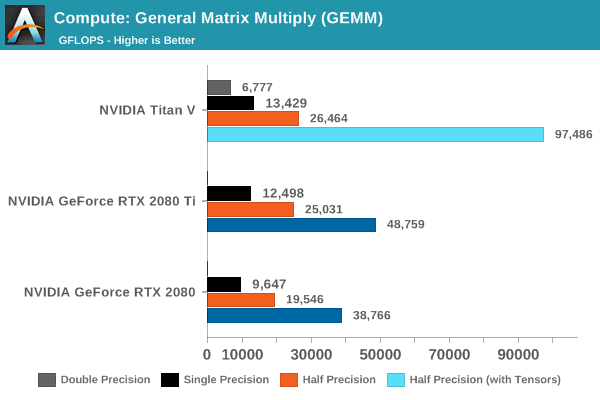
While using binaries compiled for Volta, Turing is backwards compatible in that respect as it is in the same compute capability family (sm_75 compared to Volta's sm_70). In terms of compute resources, the RTX 2080 Ti's 544 tensor cores and 1545MHz boost clock is not far off of the Titan V's 640 tensor cores and 1455MHz boost clock, so the latest Turing-optimized binaries should better reflect the RTX 2080 Ti's raw GEMM acceleration capabilities. Likewise for the 368 tensor core RTX 2080, whose tensor-accelerated HGEMM performance in TFLOPS is somewhere around 20% less than the RTX 2080 Ti.
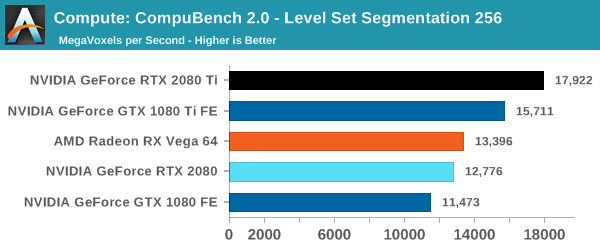
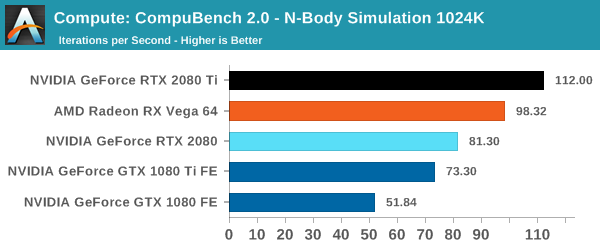
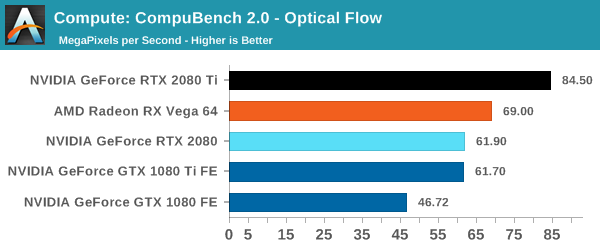
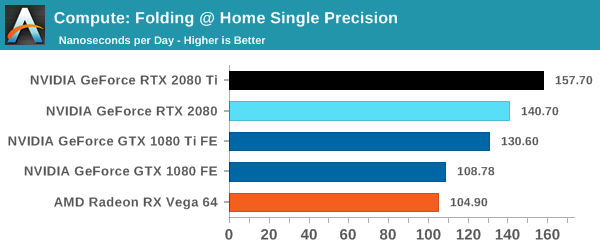

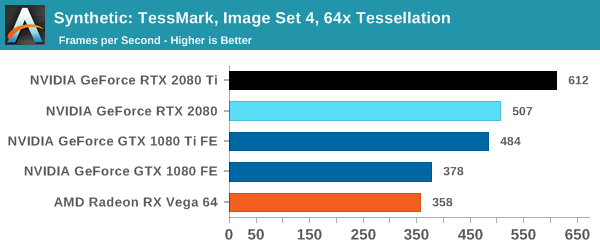
.










337 Comments
View All Comments
Midwayman - Thursday, September 20, 2018 - link
You *should* want ray tracing. Its freaking awesome. I think the question really is if it is worth the trade-off yet.Fritzkier - Saturday, September 22, 2018 - link
I agree with you. Even though Nvidia shouldn't have priced RTX that high, we still want ray tracing.mapesdhs - Wednesday, September 26, 2018 - link
I couldn't give a hoot either way, I just want games that make sense and are believable, that's far more important than how a game looks. If an object cannot be used or behave in a manner that corresponds to its appearance, then what's the point? Everyone went mental about the puddle in the PS4 game, but did anyone stop to ask whether the water on the ground was wet? Likewise, th RTX demo of that fire effect (which looked grud awful anyway), is the fire hot? Can it melt the glass if fired close enough? Can I break the glass? Use a shard as a weapon? Would an enemy reveal their position by walking on the fragments, or do the pieces just fade away because they're nothing more than a fancy PhysX visual? Can I throw a grenade into the cabin to make the glass explode and harm passing enemies?World interactivity, object function and unexpected complexity & behaviour makes for a far more immersive game than any amount of ray tracing can ever provide. A glazed china teapot can look glorious with complex reflections & suchlike, but if I can't use it to make tea than it's not a teapot. If I can't open a door, close it, lock it, break it down, etc., then it's not a door. People are obsessed with visuals in games atm because they've been told to be. The sheep behaviour of consumers with all this is utterly mind boggling.
That aside, these Turing cards are simply not fast enough for doing RT effects anyway. NVIDIA has spent the last five yers hyping people up for high frequency gaming, 4K and VR, all things which need strong fill rates (rasterisation performance). Those who've gotten used to high frequency monitors physically cannot go back, the brain's vision system adapts, standard 60Hz sudden looks terrible to such users. Now all of a sudden NVIDIA is trying to tell the very crowd with money to spend, who've largely jumped onto the HF/4K/VR bandwagon, that they should take a huge step backwards to sub-60Hz 1080p, at prices which make no sense at all. That's absolutely crazy, doubly so when dual-GPU is dead below the 2080, a card which is not usefully faster than a 1080 Ti, costs more and has less RAM.
Gastec - Thursday, September 27, 2018 - link
1000 thumbs-ups sensei! :)Writer's Block - Monday, October 1, 2018 - link
+1I'm an occasional gamer; I'd be more than an occasional gamer if games did what your suggest
Gastec - Thursday, September 27, 2018 - link
Like that freak said: "How much of your life do you not want to be Ray traced?" or some similar abomination.webdoctors - Thursday, September 20, 2018 - link
?? I knew about ray tracing before it was announced. Ray tracing isn't a new technology, its been around for more than 25 years, the idea might predate computers.Who DOESN"T want ray tracing?!
You can argue you don't want to pay a premium for it, but that's not the same thing.
mapesdhs - Wednesday, September 26, 2018 - link
I just want better games, I don't care whether they're ray traced or not. This is why I like Subnautica so much, functionally it's a far more interesting and engaging game than most I've seen recently, even though the visuals are not as sophisticated. I had been spending much time playing Elite Dangerous, but that game has become very wide with no depth, it lacks the interactivitity and depth that Subnautica captures nicely. And re my comments above, see:http://www.sgidepot.co.uk/reflections.txt
sonny73n - Thursday, September 20, 2018 - link
@V900Are you gonna reply to every comment to justify Nvidia’s rip-offs? lol
BurntMyBacon - Thursday, September 20, 2018 - link
@V900: "If you look at AMDs Vega and compare it with the previous AMD flagship: Fury, you see a similar 30-40% increase in performance.In other words: This isn’t Nvidia wanting to rip gamers off, it’s just a consequence of GPU makers pushing up against the end of Moore’s law."
Point of consideration: Though VEGA did see a lesser performance increase (not sure how accurate 30%-40% is), the MSRP of Vega64 ($500) was less than the MSRP of the FuryX ($650) and even the Fury ($550).
https://en.wikipedia.org/wiki/AMD_Radeon_Rx_300_se...
https://en.wikipedia.org/wiki/AMD_RX_Vega_series